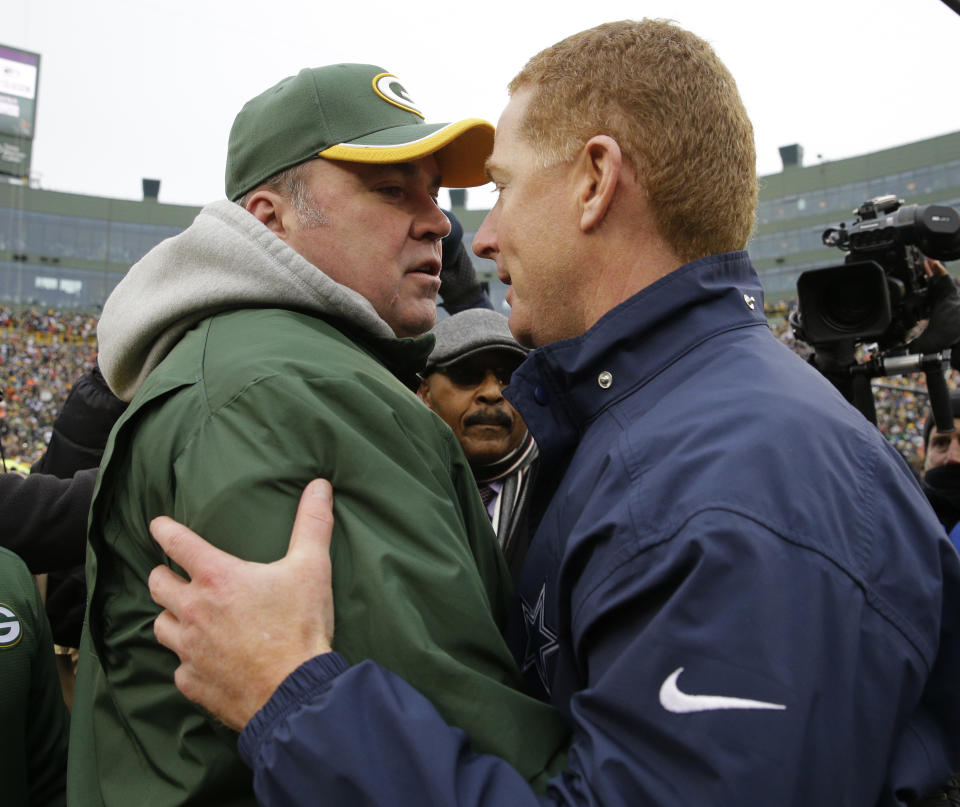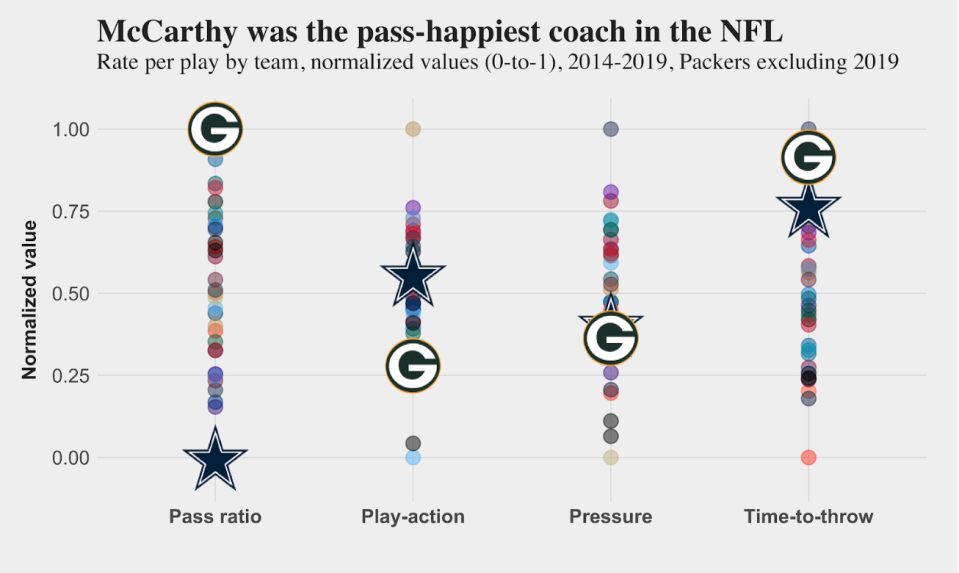Why Mike McCarthy's system might make Dak Prescott look an awful lot like Aaron Rodgers
Mike McCarthy brings to the Cowboys a résumé of success with a Super Bowl title, an impressive 125-77-2 record over 13 years, and 10 playoff victories.
McCarthy reportedly took time off during his year away from coaching to study up on league trends, and he crafted a detailed plan to incorporate more analytics into his new staff. Despite his buzzword-filled plans, opinions of the McCarthy hire aren’t universally positive. Many soured on McCarthy over the past few years of his Packers tenure as the offense generally struggled, and the drop in efficiency of his all-world quarterback Aaron Rodgers was laid at McCarthy’s feet. If he could no longer get top performances out of the best, why should he be trusted?
The perceptions of McCarthy haven’t completely shifted, but this season has bolstered the argument that Rodgers’ struggles weren’t singularly related to his coach. Rodgers’ efficiency hasn’t risen in the system of new head coach Matt LaFleur, while his passing grade has fallen year-over-year to seventh this season (79.9) from sixth a year ago (87).

The thought that McCarthy’s success was a product of his quarterback also doesn’t align with his pre-Rodgers work as the New Orleans Saints’ offensive coordinator. McCarthy orchestrated five straight league-average-or-better seasons in terms of passing efficiency for Aaron Brooks from 2000-2004. Brooks’ performance fell significantly after McCarthy’s departure and he washed out of the league a few years later.
The question is, how much can McCarthy get the best out of Dak Prescott on the heels of his best season? Prescott went from the 17th (74.3) highest-graded passer to ninth (76.8) over the past year, and was in the MVP conversation for a good portion of the fall. How McCarthy’s offensive vision aligns with what’s best for Prescott — assuming he’s returning — will be most important, as well as if he can update his offensive philosophy to match the analytical lessons coaches are incorporating more in recent years.
Comparing McCarthy’s Packers and the Cowboys
Below are the team-by-team numbers for the entire NFL from 2014-2019, with the Cowboys and McCarthy Packers (excluding 2019).

The Packers were the most pass-heavy team in the NFL under McCarthy from 2014-2018, dropping back to pass on 66.2 percent of plays. The Cowboys were on the opposite end of the spectrum, passing on 57.3 percent of plays. Some of that could be the difference in quarterbacks, though the divergence is drastic enough to indicate a philosophical difference.
One of the lessons of analytics is that teams probably still aren’t passing enough, so McCarthy’s propensity to call passes isn’t necessarily an issue. A bigger potential flaw in McCarthy’s pasts offenses is a lower play-action rate. Teams have consistently performed better with play-action than regular dropback passing, and it’s likely Prescott’s breakout this season was at least partially related to the Cowboys having the seventh-highest play-action rate (44.5 percent) in game-neutral situations. From 2015-2018, McCarthy’s Packers never ranked higher than 21st in play-action usage.
In recent years, the Cowboys have faced pressure about as often as McCarthy’s Packers, and both teams had particularly high time-to-throw averages.
Comparing route schemes
While the macro numbers show a great divergence, a closer inspection into what the offensive coach specifically controls, like route scheme, hints at something different.
PFF data scientist Timo Riske has turned our data play-by-play and receiver tracking data into a robust system for identifying and clustering pass schemes based on receiver patterns, route combinations, plus play-action and screen usage. What we find is that the scheme for the Cowboys has evolved over the years to become closer to what McCarthy was running with the Packers.
The offenses aren’t the same, but the differences between the Packers’ offensive pass scheme in 2016 and that of the Cowboys’ in 2018 and 2019 isn’t as dramatic as you might think. If McCarthy can bring a similar offense to Dallas, while incorporating more play-action passing with his tendency to pass more often, the combination could unlock the Prescott’s efficiency and volume.
Studies have shown that the idea you need to establish the run for play-action passing to work is bunk. McCarthy has the opportunity to apply these lessons on the field and deploy an offense that uses the threat of running to drive efficiency, without the drawback of actually doing it more often than necessary.
More from Yahoo Sports:

 Yahoo Lifestyle
Yahoo Lifestyle 